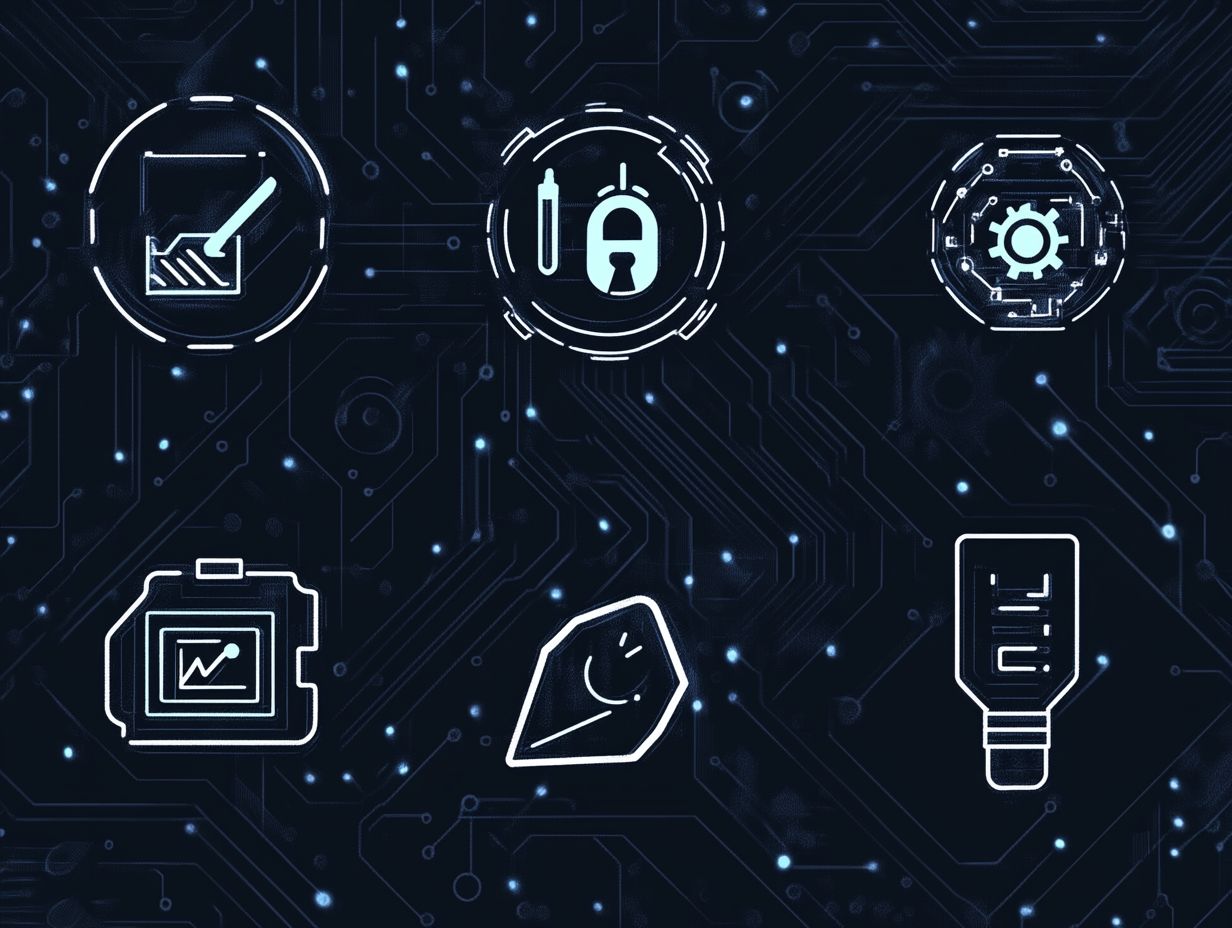top 5 incident response tools for 2024
In today’s rapidly evolving digital landscape, you can’t underestimate the importance of robust incident response tools. Act now to protect your business! As cyber threats grow increasingly sophisticated, it’s essential to equip your business with reliable solutions that effectively manage and mitigate incidents.
This article highlights the top five incident response tools for 2024, delving into their key features, costs, and how they can streamline your response processes.
You’ll discover why having the right tool is crucial, the potential risks of neglecting incident response, and best practices for implementation.
Stay ahead of the curve and safeguard your organization by grasping these essential tools and strategies.
Contents
- Key Takeaways:
- 1. Splunk
- 2. IBM Resilient
- 3. FireEye
- 4. Carbon Black
- 5. McAfee
- What Is Incident Response and Why Is It Important?
- What Are the Key Features to Look for in an Incident Response Tool?
- What Are the Different Types of Incident Response Tools?
- How Do These Tools Help Streamline the Incident Response Process?
- What Are the Costs Associated with Implementing an Incident Response Tool?
- What Are the Potential Risks of Not Having an Incident Response Tool?
- How Can a Business Choose the Right Incident Response Tool for Their Needs?
- What Are the Future Trends in Incident Response Tools?
- How Can a Business Stay Ahead of Cybersecurity Threats with the Help of These Tools?
- What Are the Best Practices for Implementing and Using an Incident Response Tool?
- Frequently Asked Questions
- 1. What are the top 5 incident response tools for 2024?
- 2. Are these tools suitable for all types of organizations?
- 3. What makes FireEye stand out among other incident response tools?
- 4. How does Carbon Black ensure efficient incident response?
- 5. Can Splunk be integrated with other security tools?
- 6. What is an extra benefit of using IBM Resilient as an incident response tool?
Key Takeaways:

- Splunk, IBM Resilient, FireEye, Carbon Black, and McAfee are the top 5 incident response tools for 2024.
- Incident response is crucial for businesses to effectively handle cyber threats and minimize damage.
- Look for key features like automation, real-time monitoring, and integration capabilities to protect your business!
- Incident response tools come in various types such as SIEM (Security Information and Event Management), EDR (Endpoint Detection and Response), and SOAR, each with its own benefits.
- Implementing an incident response tool can be costly, but the potential risks of not having one outweigh the investment.
1. Splunk
Splunk stands out as a powerful software solution, celebrated for its ability to manage incidents effectively and real-time security monitoring. It equips you with essential tools to tackle data breaches and elevate your incident response strategies.
With its advanced monitoring capabilities, you gain comprehensive visibility into your network activities, enabling you to spot potential threats before they escalate into serious issues. The incident dashboard acts as your central hub, providing real-time insights and an intuitive interface that simplifies incident tracking, making it both straightforward and efficient.
Robust alerting systems ensure that your teams are promptly notified of any anomalies or suspicious activities, crucial for timely decision-making. Splunk integrates seamlessly with various technologies to enhance your overall incident analysis and troubleshooting, fostering a synergistic environment that strengthens your organization s resilience and responsiveness.
2. IBM Resilient
IBM Resilient distinguishes itself as a comprehensive incident response platform designed to elevate your incident handling processes. With its intuitive automation tools, it ensures seamless collaboration and business continuity, making your team s life significantly easier.
By integrating effortlessly with your existing security tools and systems, it enables you to manage the entire incident lifecycle with remarkable efficiency. This capability allows for real-time data sharing and strengthens communication among users, enabling you to identify threats more quickly and respond at an accelerated pace.
The platform s collaborative features enhance risk management, allowing you and your stakeholders to analyze incidents together and assess potential impacts. This integration promotes a more agile and unified strategy for handling security incidents, ultimately bolstering your organization s resilience against ever-evolving threats.
3. FireEye
FireEye specializes in advanced threat detection, equipping you with essential tools for incident control and tracking critical elements for effectively mitigating security threats. By harnessing sophisticated analytics and real-time monitoring, their offerings significantly enhance your ability to swiftly identify, analyze, and respond to incidents.
The incident analysis capabilities of their platform provide your security team with profound insights into potential vulnerabilities and threats, enabling you to take proactive measures before issues escalate. FireEye’s comprehensive suite arms you with automated workflows and detailed reporting features, simplifying communication and collaboration during a security event.
This consolidation of intelligence strengthens your security operations and elevates your overall response capabilities, helping your organization maintain robust defenses in an ever-evolving threat landscape.
4. Carbon Black
Carbon Black stands out in threat management solutions. It provides powerful incident response capabilities that enhance log management and optimize software performance.
Its advanced threat detection uses machine learning and behavioral analytics to spot unusual activities in real-time. By integrating with various monitoring tools, it offers a comprehensive view of your organization’s security posture.
This helps your team respond swiftly and effectively to incidents. With clear visibility into operations, the platform delivers detailed insights into potential vulnerabilities and the current status of your endpoints.
Security professionals can make informed decisions. This holistic approach streamlines incident analysis and strengthens defenses against emerging threats.
5. McAfee

McAfee is a leading name in security monitoring. It offers comprehensive incident response tools that enhance user experience and deliver impressive software ratings.
This robust platform excels in handling incidents, allowing you to manage security breaches quickly and effectively. With proactive threat detection, you receive real-time alerts to identify potential risks before they escalate.
McAfee integrates seamlessly with various third-party tools, enhancing its functionality. This integration streamlines workflows and aligns security measures with broader organizational goals.
What Is Incident Response and Why Is It Important?
Incident response is a structured approach to managing the aftermath of a security breach or cyberattack. It s essential for protecting your data and maintaining business continuity.
The incident lifecycle has critical phases designed to improve your organization’s resilience against future threats. It begins with thorough preparation, where you develop plans and train your teams.
Next, detection is pivotal; real-time monitoring helps identify any unusual activities. After detection, you analyze the situation to understand its scope and impact.
Then, you contain the incident by taking immediate actions to limit damage. Once contained, you move to the eradication phase to eliminate the root cause.
The recovery phase follows, restoring systems and data to normal operations. By engaging in effective risk management throughout these phases, you enhance your strategies and foster a culture of security and resilience.
What Are the Key Features to Look for in an Incident Response Tool?
When choosing an incident response tool, consider features like communication capabilities and user-friendly automation tools. An intuitive incident dashboard fosters seamless team collaboration.
These elements are vital for smooth incident management. Strong communication capabilities allow for immediate updates and feedback, reducing misunderstandings during critical times.
User-friendly automation tools reduce manual tasks, letting your team focus on strategic responses. An intuitive dashboard provides a centralized view of incidents for quick decision-making.
Together, these features improve the incident lifecycle, enabling a more effective and agile response to challenges.
What Are the Different Types of Incident Response Tools?
There s a wealth of incident response tools at your disposal. These range from sophisticated software solutions to versatile open-source options, each with unique integration capabilities tailored to various facets of incident management.
You can categorize these tools into several essential areas:
- Threat detection: This means using advanced algorithms and machine learning to pinpoint suspicious activities before they escalate into significant issues.
- Incident tracking: Keeping an eye on ongoing security problems ensures they are resolved quickly.
- Alerting mechanisms: These are vital for notifying everyone about security breaches or anomalies in real-time.
Incident tracking tools enable your teams to monitor the status of ongoing incidents, ensuring that nothing slips through the cracks.
Proprietary software often provides sleek interfaces and dependable customer support. Open-source tools may present usability challenges and require a deeper technical understanding. However, their adaptability for your specific needs often makes them worth considering, despite the potential trade-offs.
How Do These Tools Help Streamline the Incident Response Process?
Incident response tools are essential for streamlining your incident response process. They provide real-time alerts and facilitate thorough incident analysis.
These tools also enhance team collaboration throughout the entire incident lifecycle. By optimizing workflows, they significantly reduce response times, enabling your team to swiftly address emerging threats.
With features designed for seamless information sharing and task assignment, these tools ensure that everyone is aligned and working toward a common goal.
They also integrate various communication channels, promoting better coordination among diverse teams. This coordination is crucial for effectively managing incidents and minimizing disruption.
Ultimately, this leads to a proactive approach to incident management, enhancing your organization s overall resilience.
What Are the Costs Associated with Implementing an Incident Response Tool?

Implementing an incident response tool entails various costs you need to be aware of. These include software licensing, training, and operational expenses.
These costs can accumulate quickly, leading to a hefty initial expenditure that you must evaluate against your budgetary constraints.
Don’t overlook ongoing expenses like system updates, maintenance, and potentially hiring staff for effective management.
As you weigh these costs, consider the substantial financial implications of potential security incidents. These can include data breaches, lost productivity, and damage to your reputation.
Understanding this comparison enables you to make informed decisions about investing in an incident response tool that addresses your current needs and mitigates future risks.
What Are the Potential Risks of Not Having an Incident Response Tool?
Neglecting to implement an incident response tool can expose your organization to considerable risks. These include increased security threats, service disruptions, and loss of customer trust all of which may lead to ongoing operational challenges.
Consider the case of a prominent healthcare provider in 2017 that fell victim to a ransomware attack. This incident paralyzed its systems and delayed patient care, leading to an estimated loss of millions.
This serves as a stark reminder: without robust incident management strategies, organizations face immediate setbacks and lasting reputational damage.
If you overlook proactive incident response measures, you may find yourself ill-equipped to navigate the complex landscape of cybersecurity incidents. This leaves your organization vulnerable to further breaches.
Don’t wait until it’s too late! Effective tools are essential for protecting your organization now.
Explore our recommended tools today!
How Can a Business Choose the Right Incident Response Tool for Their Needs?
Selecting the right incident response tool demands a thorough evaluation of your business needs. Consider factors like integration capabilities, performance metrics, and the tool’s effectiveness in tackling specific security challenges.
Start your evaluation process with a comprehensive comparison of available tools. Assess features that resonate with your organization s unique requirements.
Delve into product ratings and expert opinions to get a sense of user experiences and reliability. Engaging key stakeholders in discussions can reveal invaluable insights.
This ensures that the chosen solution meets not only the technical requirements but also aligns with your broader organizational goals. By meticulously combining these steps, you can confidently identify the most suitable incident response tool that will significantly enhance your security posture.
What Are the Future Trends in Incident Response Tools?
The future of incident response tools is set to be defined by emerging trends. These include enhanced technology integration, advanced automation tools, and a stronger emphasis on active threat prevention.
These advancements indicate a shift in approach, where organizations are not merely reacting to incidents. They are actively anticipating them before they escalate.
This proactive stance demands sophisticated data analytics and machine learning algorithms capable of real-time anomaly detection. As artificial intelligence continues to integrate into these processes, teams can respond more effectively.
They can prioritize threats and optimally allocate resources. With the digital landscape growing increasingly complex, the evolution of incident response tools will likely focus on adaptability and transparency.
This ensures that you, as a stakeholder, have clear visibility into ongoing security operations and the efficacy of your incident response measures.
How Can a Business Stay Ahead of Cybersecurity Threats with the Help of These Tools?
You can stay ahead of cybersecurity threats by harnessing incident response tools that offer robust monitoring capabilities and real-time alerts. This ensures you detect and respond to emerging risks promptly.
To maximize the effectiveness of these tools, establish seamless monitoring integrations that connect various data sources. This allows for real-time threat analysis.
Utilize automated alerts tailored to specific incidents to implement proactive measures. Respond swiftly to any suspicious activities.
Conducting regular incident analyses is vital for identifying vulnerabilities. This enhances your overall security protocols and strengthens your organization s long-term security posture against potential attacks.
What Are the Best Practices for Implementing and Using an Incident Response Tool?

Implementing and effectively using an incident response tool requires you to follow best practices. These include ensuring seamless integration, fostering collaboration among your team, and leveraging communication features that enhance operational efficiency.
Prioritize comprehensive training now to equip your team for any incident. This enables them to navigate the tool with confidence and respond promptly to incidents.
Regular assessments are crucial for identifying gaps and reinforcing your defense mechanisms. This ensures your organization remains resilient.
Stay informed about evolving cybersecurity threats to enable your team to adapt their strategies and tools dynamically. Keep pace with the latest security protocols.
By embracing these practices, you can maximize the effectiveness of your incident response tools. This ultimately safeguards your organization against potential vulnerabilities.
Frequently Asked Questions
1. What are the top 5 incident response tools for 2024?
The top 5 incident response tools for 2024 are FireEye, Carbon Black, Rapid7, Splunk, and IBM Resilient. These tools have been consistently ranked as the most effective and reliable in handling security incidents.
2. Are these tools suitable for all types of organizations?
Yes, these tools are suitable for organizations of all sizes and industries. They offer customizable features and can be tailored to meet the specific needs of different organizations.
Don’t wait start strengthening your incident response strategy today!
3. What makes FireEye stand out among other incident response tools?
FireEye is renowned for its advanced threat intelligence. It combines machine learning, behavioral analysis, and expert insights to detect and respond to threats in real-time.
4. How does Carbon Black ensure efficient incident response?
Carbon Black specializes in endpoint detection and response. It provides a complete view of an organization s endpoints, enabling quick identification and resolution of security incidents.
5. Can Splunk be integrated with other security tools?
Absolutely! Splunk integrates with various security tools, including Security Information and Event Management (SIEM) systems, firewalls, and antivirus software. This integration fosters centralized incident response and enhances collaboration among security teams.
6. What is an extra benefit of using IBM Resilient as an incident response tool?
IBM Resilient features a built-in playbook for automating incident response workflows. This automation saves time and boosts efficiency when addressing security incidents.






